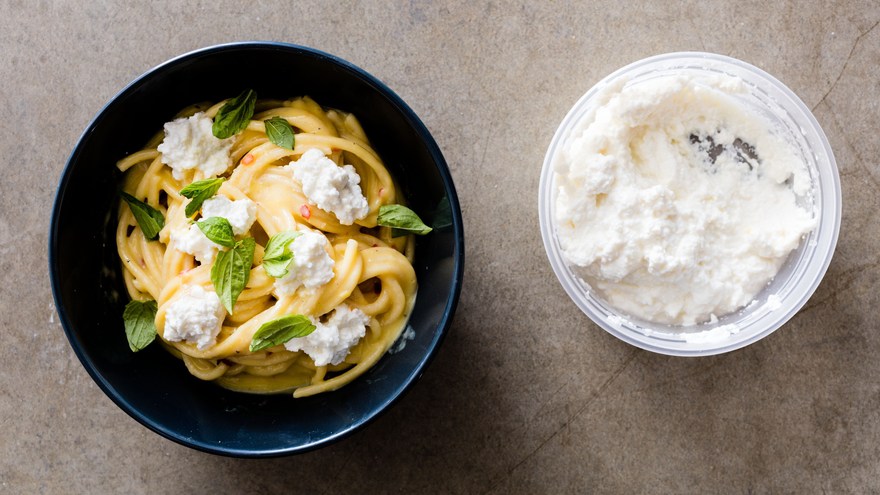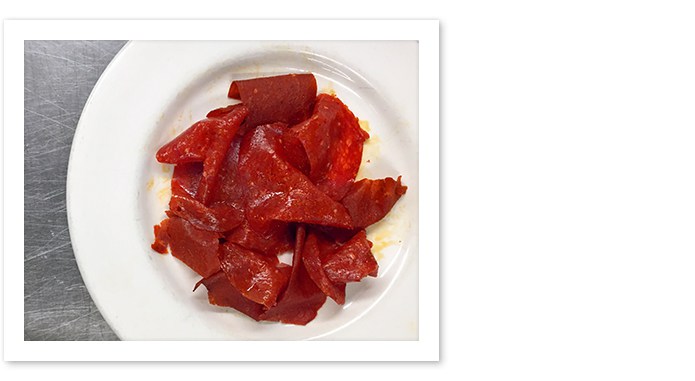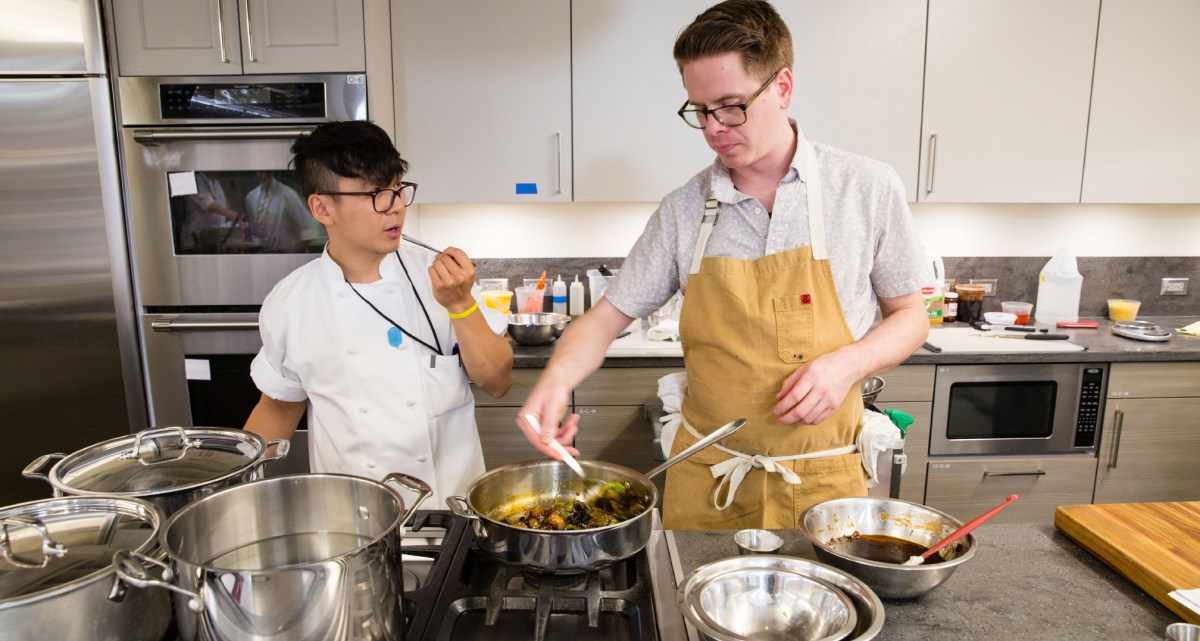In this new weekly series, Associate editor Tim Chin and Test cook Sasha Marx take you behind the scenes of Cook’s Science and give you a glimpse into our recipe development process, from how we come up with recipe ideas, to test kitchen failures, to discoveries we make along the way.
From Sasha:
Tim and I are often asked by friends and family what exactly we work on all day in the kitchen. In fact, even our colleagues here at America’s Test Kitchen ask us the same question, often with raised eyebrows as we are setting up incubators or dehydrating tapioca slurry, the appearance of which could best be described as non-radioactive Ghostbusters slime. Our days are mainly consumed by failed experiments, bad food puns, tasty snacks, and the odd culinary eureka moment. We thought it would be fun to start documenting and sharing some of these moments to give a better sense of what our day to day experiences are like in the test kitchen of Cook’s Science.
I started working at Cook’s Science this past summer after spending two years in Chicago as a sous chef at Parachute Restaurant. One of the things I was most excited about when I transitioned from the grind of the restaurant schedule to a more normal 9-to-5 life was the possibility of cooking more at home for loved ones and myself. Alanis Morissette would agree that one of the tragic ironies of cooking in restaurants is that you rarely, if ever, have the time or energy to cook at home. I think I hit rock bottom working the wood oven station at a restaurant in Maine where I would make awesome Neapolitan pies all night and then go home and order Papa John’s. I’m glad those days are (hopefully) behind me.
At Cook’s Science we’ve been developing some quick, simple, and delicious recipes for mid-week dinners that call for something a little more approachable than our more project-heavy, impress-your-Tinder-date recipes (just being able to pronounce nixtamalization should get you a second date). For my first mid-week dinner recipe the team and I decided that I would tackle something pasta-related. I was totally down with this, mainly because I am always craving pasta, and if I can disguise my need for bucatini as recipe research and development, why not? We had some extra corn kicking around in the test kitchen, so I got to work on cobb-ling (I’m going to try to sneak as many food puns past our editors as possible) something together. The result: Creamy Corn Bucatini with Corn Ricotta and Basil.
During our early brainstorming, I had joked about making a “cornbonara” pasta dish and I decided to run with it. I was quickly able to develop a corn puree that mimicked the rich, egg yolk texture of a classic carbonara. An early version that mixed the corn purée with pancetta was tasty but struck me as a little too cute and gimmicky. I decided to ditch the pork and focus on the corn. Ricotta struck me as a another way to bring some needed fat to the dish—it’s unbelievably easy to make at home, and By steeping corn in the milk used to make the ricotta, I was able to bring even more corn flavor to the party.
From this point, the dish came together quickly (not something that happens very often, as I soon learned—stay tuned). Even though we were developing the recipe in summer—peak corn season—I wanted to see if it would work just as well if someone wanted to make it in February (read: NOT peak corn season). I tested the process with frozen corn kernels in lieu of fresh and had my team do a taste test of one recipe made with fresh corn and one made with frozen. They, lucky for me, weren’t able to detect a difference. After some additional testing and tweaking, we sent the recipe to a panel of home cooks to try it out and give us feedback on both the process (the recipe) and the finished product. A few more adjustments to the consistency of the sauce, and we were ready to call it a day.
However, recipe writing was not as much of a breeze for me. This was the first recipe I developed and wrote at Cook’s Science and I had been warned by our Executive editor Dan Souza that it’s a pretty steep learning curve. He was right. I was coming from restaurants where recipes are, at best, a list of grammed-out ingredients followed by shorthand instructions: “slice and sweat veg, blend on high, pass through chinois, chill.” Not exactly something we could publish and guarantee home cooks’ success. Now I had to step back and really examine all of the steps I was taking during cooking. Exactly how many seconds did I blend the corn purée? Precisely how much pasta water did I add to the sauce? Did I need to strain the ricotta through cheesecloth or would a fine mesh strainer suffice on its own? Answering questions like this meant going back to the test kitchen to cook through the recipe again and again, recording measurements, and paring out unnecessary steps. It’s a lot of work. A lot of delicious work.

From Tim:
I spend a lot of time in the kitchen failing. And coming from the restaurant world, where failure can mean getting pulled off the line and being ridiculed by my chef—or worse, resulting in my own unemployment—the notion of failure is unsettling. But, since landing at America’s Test Kitchen a year ago, first on the book team, and now on the Cook’s Science team, I’ve found that sometimes failure can be a gateway to discovery. Sometimes failure encourages me to explore things that might otherwise never have seen the light of day here at Cook’s Science—but that nonetheless make our lives mildly more interesting.
I was playing around with different variations on the Butternut Squash Gnudi recipe I’d been working on, and thought that sun-dried tomato might be a cool flavor base as a substitute for butternut squash. Traditionally, gnudi are dumpling-like pillows of ricotta and semolina flour that are a close cousin to gnocchi. Instead of ricotta and semolina flour, I opted for a non-traditional approach using egg white powder and tapioca starch to bind the filling and create solid little bite-size gnudi with maximal squash flavor. The egg white powder helps form a stable gel via the coagulation of albumin proteins in the egg white and also contributes to the gnudi’s custardy texture. The tapioca starch is there to bind water and help with gelation, working in combination with the egg white powder to form an even more stable but creamy gel.
My first attempt involved rehydrating a jar of sundried tomatoes by gently simmering them in crushed tomatoes to maximize the tomato flavor, blending them up, and incorporating them into my working gnudi formula in place of the butternut squash. The results sucked. The gnudi never set up properly, so I was left with a hot mess of egg white- and starch-thickened tomato purée. I tried bumping up the proportion of tapioca starch to increase the gelling potential of the base. This time, the gnudi properly set up, but the texture was pretty appalling. I ended up with fire-red hot dog-looking logs that had a bizarre, crumbly texture—nothing creamy at all.
I made a few more tweaks to the amounts of tapioca starch and egg white powder, but after a particularly harrowing team taste test, we agreed that this recipe idea was a non-starter. But I had all this tomato-y goodness left over from my last failed gnudi attempt. Sasha suggested that we spread it on large sheet pans and dry it out in our dehydrator. We basically ended up with tomato-flavored fruit leather—pliable, twisty, and reminiscent of a Totino’s pizza roll. Since we’re tight on space in the test kitchen these days, we keep our dehydrator in our office upstairs next to the marketing department. The whole floor smelled like a pizza shop for a solid week.

Photography by Steve Klise and Daniel J. van Ackere.
